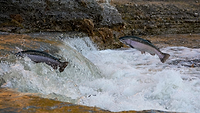Study: Illinois Fish Contaminated With Concerning PFAS Levels

Image credit: Alexas_Fotos via Pixabay
A recent study led by University of Illinois, Urbana-Champaign researchers has found the widespread presence of toxic per- and polyfluoroalkyl substances (PFAS) in the tissues of fish sourced from various Illinois water bodies.
PFAS, also known as “forever chemicals” due to their inability to break down in the environment or the human body, have been widely used in consumer products for decades. The chemicals have been a subject of increasing concern due to the mounting body of evidence about their harms to human health and their prevalence in crops, water, and people.
For their study, the researchers focused on PFAS in fish because fish are crucial bioindicators for contamination in water, and fish are also eaten by the general public. The researchers collected fish from 15 sampling points across four Northwestern Illinois waterways (Rock River, Pecatonica River, Sugar River, and Yellow Creek) during 2021–2022, targeting nine species commonly captured by fishers (Bluegill, Common Carp, Smallmouth Bass, Walleye, Channel Catfish, Sauger, Smallmouth Buffalo, Black Crappie, and Northern Pike). Concentrations of 17 important PFAS compounds were evaluated.
Analysis of fish tissues revealed that PFAS were present in fish from all locations, with varying concentrations depending on the specific water body and fish species. Notably, perfluorooctane sulfonic acid (PFOS), a particularly pervasive and harmful type of PFAS, was found most frequently in some sampling periods, with levels exceeding advisory thresholds for human consumption in some samples. Elevated levels of the chemical were observed in nearly all fish, indicating the need for careful consideration of fish consumption.
Perfluoroalkanecarboxylic acid (PFHxA) was seen to be the most accumulated PFAS in the year 2022, while perfluorobutane sulfonate (PFBS) and PFOS dominated in 2021. Additionally, the highest concentrations of PFAS were consistently found in samples from the Rock River, especially in areas near urban and industrial activities.
The study also found significant differences in PFAS concentrations between different species of fish. Bottom-dwelling fish, which are more likely to come into direct contact with contaminated sediments, generally had higher levels of PFAS compared to species that are not bottom-dwelling. Specifically, Channel Catfish exhibited the highest PFAS content across different fish species, indicating its bioaccumulation potential across the food chain.
The researchers call for the collection of additional bioaccumulation data in the future years to shed light on the sources and PFAS contamination of aquatic wildlife in relation to exposures for potential health risk assessment.
Looking for a reprint of this article?
From high-res PDFs to custom plaques, order your copy today!






